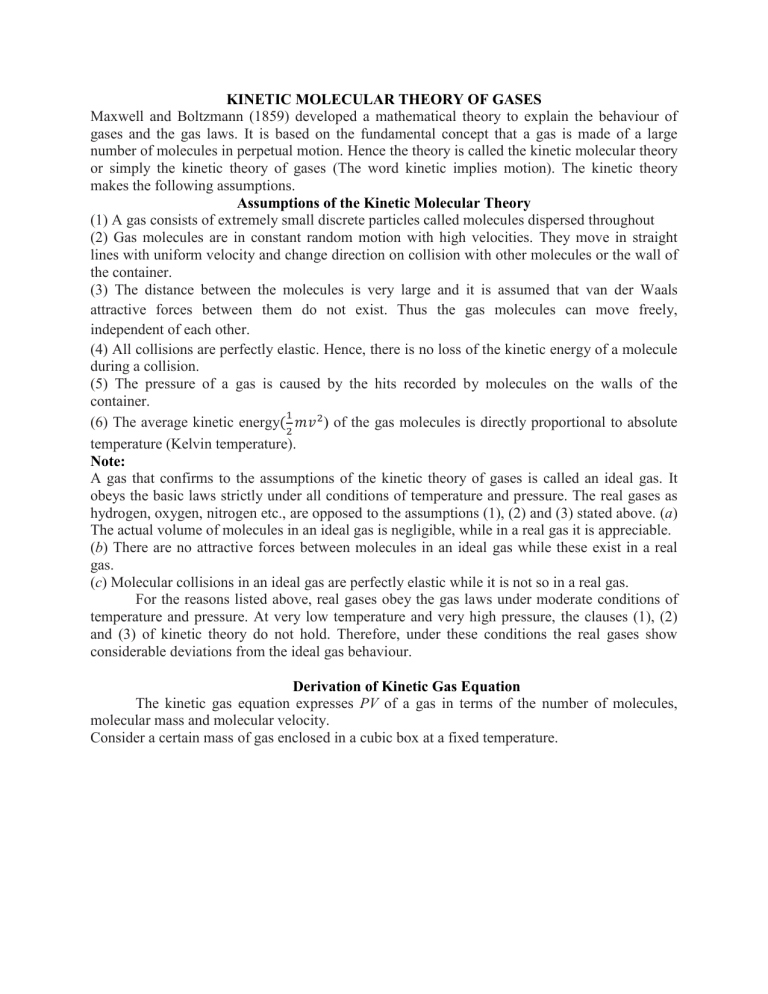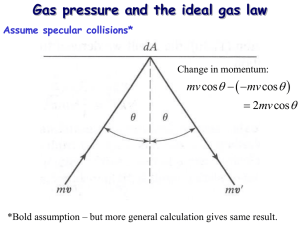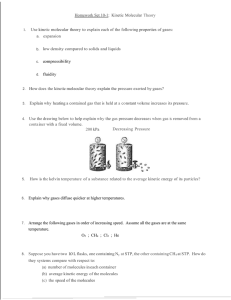
KINETIC MOLECULAR THEORY OF GASES Maxwell and Boltzmann (1859) developed a mathematical theory to explain the behaviour of gases and the gas laws. It is based on the fundamental concept that a gas is made of a large number of molecules in perpetual motion. Hence the theory is called the kinetic molecular theory or simply the kinetic theory of gases (The word kinetic implies motion). The kinetic theory makes the following assumptions. Assumptions of the Kinetic Molecular Theory (1) A gas consists of extremely small discrete particles called molecules dispersed throughout (2) Gas molecules are in constant random motion with high velocities. They move in straight lines with uniform velocity and change direction on collision with other molecules or the wall of the container. (3) The distance between the molecules is very large and it is assumed that van der Waals attractive forces between them do not exist. Thus the gas molecules can move freely, independent of each other. (4) All collisions are perfectly elastic. Hence, there is no loss of the kinetic energy of a molecule during a collision. (5) The pressure of a gas is caused by the hits recorded by molecules on the walls of the container. (6) The average kinetic energy ) of the gas molecules is directly proportional to absolute temperature (Kelvin temperature). Note: A gas that confirms to the assumptions of the kinetic theory of gases is called an ideal gas. It obeys the basic laws strictly under all conditions of temperature and pressure. The real gases as hydrogen, oxygen, nitrogen etc., are opposed to the assumptions (1), (2) and (3) stated above. (a) The actual volume of molecules in an ideal gas is negligible, while in a real gas it is appreciable. (b) There are no attractive forces between molecules in an ideal gas while these exist in a real gas. (c) Molecular collisions in an ideal gas are perfectly elastic while it is not so in a real gas. For the reasons listed above, real gases obey the gas laws under moderate conditions of temperature and pressure. At very low temperature and very high pressure, the clauses (1), (2) and (3) of kinetic theory do not hold. Therefore, under these conditions the real gases show considerable deviations from the ideal gas behaviour. Derivation of Kinetic Gas Equation The kinetic gas equation expresses PV of a gas in terms of the number of molecules, molecular mass and molecular velocity. Consider a certain mass of gas enclosed in a cubic box at a fixed temperature. If: the length of each side of the box = l cm the total number of gas molecules = n the mass of one molecule = m the velocity of a molecule = v The kinetic gas equation may be derived by the following steps: According to the kinetic theory, a molecule of a gas can move with velocity v in any direction. (i) The velocity of the components is expressed as: (Gas can move with velocity, v, in any direction). (ii) The number of collision per second = (one face) (iii) The total change in momentum = mv- (-mv) = 2mv (iv) The total change in momentum per second = = = (v) The overall change of momentum per second on all faces. The change of momentum on both the opposite faces A and B along X-axis would be double i.e. = = (vi) For all molecules of gas, where there are N molecules = ) = Where is the mean square velocity Recall from Newton’s second law of motion, force is the change of momentum per time. F= Calculation of pressure from force Pressure = P= P= (total area = P= ( PV = = volume) This is called the Kinetic Gas Equation. Note: U2 is the mean of the square of the individual velocity of all the N molecule of the gas. But U = √ , therefore U is called the Root Mean Square or (RMS) velocity. A molecule possessing the average kinetic energy moves at this velocity. Derivation of Gas Laws from Kinetic Gas Equation 1. Boyle’s Law: According to kinetic theory, there is a direct proportionality between absolute temperature and the average kinetic energy. αT Or = KT Recall: PV = Therefore, PV= KT PV = KT (2/3 is a constant value) PV = KT P= Pα (This is Boyle’s Law)


